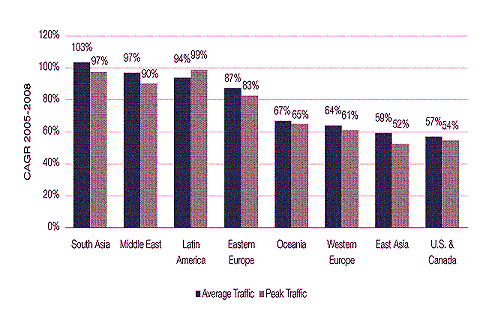 A new study entitled WebDialn@ (meaning ‘our web’ in the Arab Algerian accent) by Med&Com and Ideatic that polled about 6,000 Algerian internet users on ADSL, mobile internet, online advertising and e-commerce, estimates that 4.5 million people (12.8% of the Algerian population) use the internet, and that they heavily rely on it for news, research and activities such as social networking.
A new study entitled WebDialn@ (meaning ‘our web’ in the Arab Algerian accent) by Med&Com and Ideatic that polled about 6,000 Algerian internet users on ADSL, mobile internet, online advertising and e-commerce, estimates that 4.5 million people (12.8% of the Algerian population) use the internet, and that they heavily rely on it for news, research and activities such as social networking.
75% of Algerian internet users call the web an “indispensable tool”, with more than 90% confessing to “not being able to get by without going online ‘at least once a day'”. Most users reported spending two hours on average in front of their monitors.
The study also shows a gender gap and regional disparities in internet use. The typical Algerian Web user is described as male (72.2%), aged between 20 and 29 (29.2%), educated at least to the baccalaureate level + 1 (66.2%), and living in Algiers (29.28%). However, women represent just 25.8% of Algerian Web users.
The researchers reported that 82.6% of Web users communicate via email. Of this percentage, 42.5% also use instant messaging (such as MSN or Yahoo Messenger), 33.8% visit discussion forums, 33% make telephone calls over the Internet (Skype), and 9.9% use video conferencing.
Online media are the Algerian web users’ top online destinations, with 80.8% reading online newspapers, 19.9% listening to the radio, and 11.4% watching TV programmes. The internet is also used for research (80.7%) and making business contacts (22.9%). Social networks seem to be quite popular too with 40% of respondents having profiles on Facebook.
The study also shows that Algerians aren’t very active contributors, with 82.2% visiting online media-sharing sites (YouTube, DailyMotion, Flickr), but only 23.5% contributing.
Numbers from the Algerian Post and ICT Ministry say that there are 585,455 residential ADSL subscribers in the country. Nearly 65% of those surveyed said they can log on from home, compared with 24.6% who log on at work. Over 61% of web users say there are at least three people using the internet in a single home. Youth clubs and libraries with internet access, which used to be crammed, are hosting fewer users.
Some 72.1% of users say they are unsatisfied with the speed of their connection at home, and 79.7% complain about frequent service outages. 53.8% of Web users think the connection rates are affordable, while 43.8% of them think subscription rates are expensive or very expensive.
A presentation of the study results is available here in French: WebDialn@ Study Results (PDF)
[Source: Magharebia]


